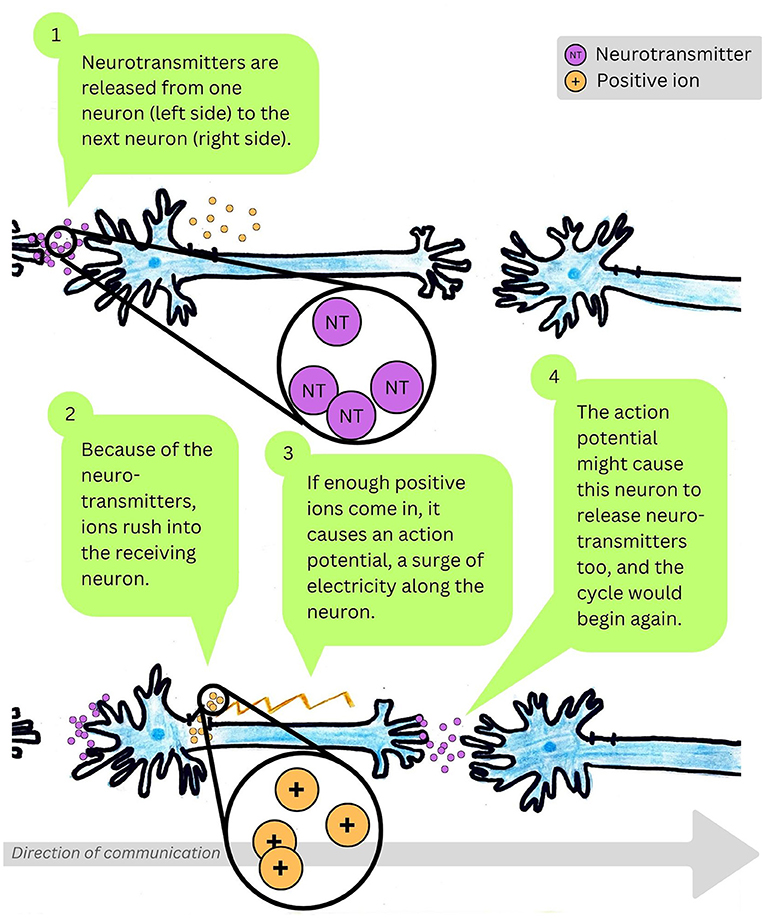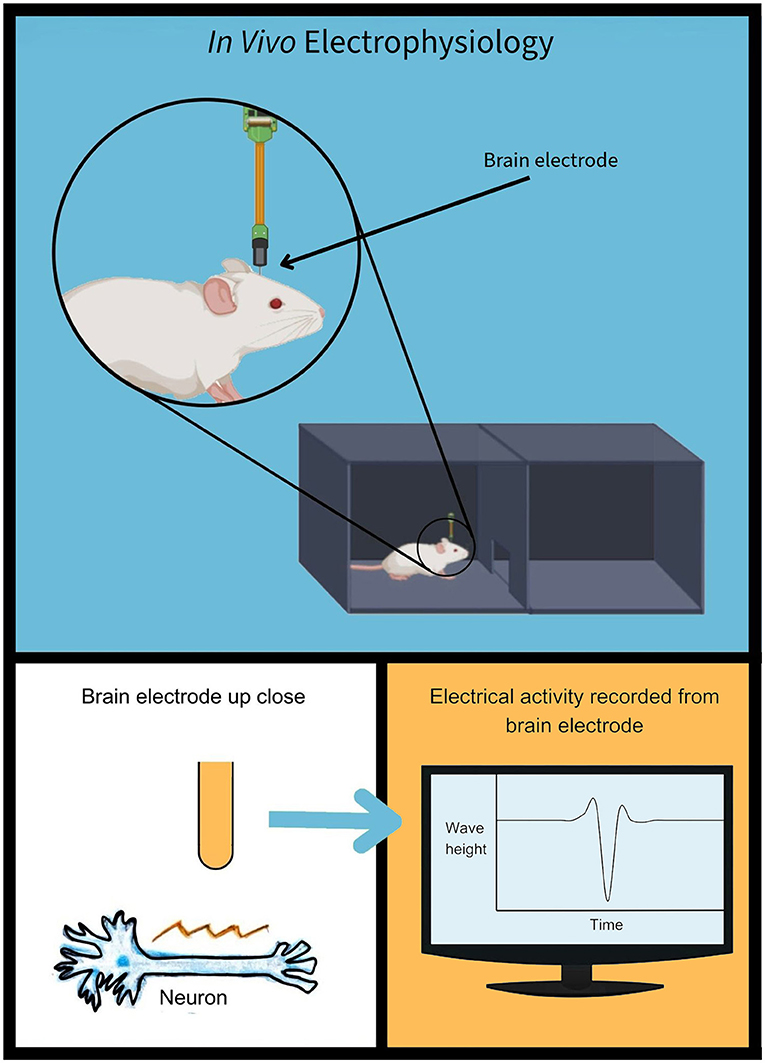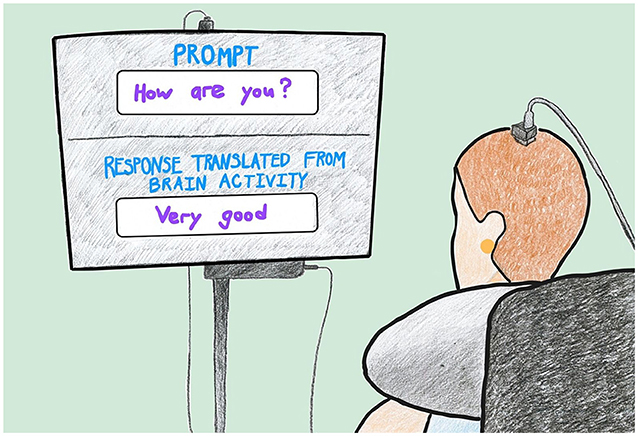Abstract
Electrophysiology is the study of the body’s electricity. It is also one way that scientists study brain cells called neurons. In vivo electrophysiology is a technique that allows us to study what is happening among groups of neurons in living organisms. The “in vivo” part of the term means “in life”. Measuring electrical activity from living organisms can uncover real-time communication between neurons, which helps us understand how the brain produces behavior. As we study the brain and learn more about how it works, we can get a better grasp of brain disorders and brain-related disabilities—and hopefully find new ways to treat them.
How do Neurons in the Brain Work?
The brain is made up of many types of cells, and neurons are a major type. To communicate with each other, neurons send little chemical messengers, called neurotransmitters, from one neuron to the next (Figure 1, step 1). When a neurotransmitter is received by a neuron, positively or negatively charged substances called ions rush inside that neuron. If negative ions enter, then the signal stops. However, if enough positive ions build up in the receiving neuron, this triggers an Action potential. An action potential is like a surge of electricity that travels down the neuron. When the action potential reaches the end of the neuron, it causes neurotransmitters to be released again, which travel to the next neuron, and the cycle starts over (Figure 1, steps 2–4).

- Figure 1 - Neurons communicate through a process involving neurotransmitters, ions, and electricity.
- While other types of communication also happen between neurons, and neurons come in other shapes and sizes, this figure shows the core idea of neural communication (Image created in Canva).
There are about 100 billion neurons in the brain. Neurons also connect with the body’s muscles and glands and send signals from the body to the brain. At any moment, a lot of neurons are firing action potentials. By working together, neurons help us think, feel, move, breathe, and experience life events.
Our Brains are Complicated!
There is a lot going on in the human brain. Most of the time the brain works properly, but sometimes things can go wrong. For example, when someone is having a seizure, their neurons are overactive, and this might cause them to lose control of their movements. When our brains have problems like this, it can be very difficult for scientists to figure out why. Additionally, different brain disorders can be hard to tell apart from each other. Because of these factors, it might seem impossible to study the brain. How do we get past this obstacle? The answer lies in an interesting trait of neurons—their electricity can be measured.
What is Electrophysiology?
Electrophysiology is the study of electrical activity in different parts of the body. In the brain, electrophysiology can be used to measure the electrical communication of neurons. It is kind of like eavesdropping on neurons while they talk to each other. With the help of some advanced equipment, we can even record neurons while they are alive and functioning within a person’s brain. This means we can get data about the brain that we might not be able to get by simply observing dead brain tissue or by observing the brain’s blood flow. In addition, electricity is a key aspect of brain function, so tracking electricity means directly monitoring brain activity [1].
People have been engaging in electrophysiology for over a century. In the 1780s, a professor named Luigi Galvani electrically stimulated a dead frog’s leg [2]. Upon stimulation, the leg muscles twitched. After the experiment, Galvani and other scientists began questioning what the muscle twitching meant about how muscles, Nerves, and electricity work in animals. Over many decades this led to various scientific advancements, including the discovery of the action potential. This knowledge also led to the development of modern electrophysiological techniques.
These techniques can involve stimulating a body part, like in Galvani’s experiment, but they also include observing how tissues and organs naturally function with electricity. Particularly, electrophysiology is one of the best ways to get valuable information about the electrical activity of the brain. This includes how drugs can affect ions rushing into neurons, how the electrical activity of certain brain areas affects other brain areas, and how the brain’s overall electrical activity influences our actions. These days, electrophysiological techniques basically come in three categories. The first one is electrical monitoring inside a single neuron. The second is electrical monitoring from outside neurons, which is called Extracellular recording. The third category is monitoring from outside the brain. Let us take a look at the second category, extracellular recording. When this is done in the brain of a living creature, it is called In vivo electrophysiology. The “in vivo” part of the term means “in life”.
Observing Neurons in Living Creatures!
During in vivo electrophysiology, small pieces of metal called electrodes are placed into one or more brain areas. They capture live electrical recordings, and this can be done on animals like rats and monkeys. Since there are no pain receptors in the brain, the animals do not feel pain from the procedure. However, these types of studies require lots of training, specialized equipment, and approval by an animal research ethics committee known as the Institutional Animal Care and Use Committee. Do not try this on your pet at home! When the neurons in the animal’s brain fire action potentials, the electrodes pick up the electricity of those neurons. This electricity is displayed as waves visible on a computer screen.
Waves observed from neurons in different brain areas can inform scientists about neural activity. For example, the amygdala is a brain area associated with fear and aggression. High levels of electrical activity coming from this area might mean that the research animal is scared. In vivo electrophysiology can be used to understand other emotions too, and it even informs us about behavior.
How Has in vivo Electrophysiology Helped People?
In vivo electrophysiology can help scientists get detailed information about neural activity, but the benefits do not stop there. When combined with other technologies, it can directly help people in need. Brain computer interfaces (BCIs) are a good example. BCIs allow direct communication between a brain and a computer. They come in many forms, but some use electrodes that pick up the electrical activity of neurons in a similar way to that shown in Figure 2. The basics are the same: electrodes sit among neurons and listen to their conversations. The difference is that BCIs then relay the conversation to a computer that performs an action, like translating the brain activity to speech [3]. This kind of BCI provides people with speech disabilities another way to communicate.

- Figure 2 - In in vivo (in life) electrophysiology, an animal has electrodes surgically inserted into its brain.
- It is then allowed to freely move around, sometimes in a box like the one shown. While the animal moves around, its brain electrical activity can be read on a computer screen in real time. This can help scientists get accurate information about what is happening in the animal’s brain [Created in BioRender. Ojerinde, L. (2025) https://BioRender.com/d24m158].
In vivo Electrophysiology Can Make a Difference
Observing neurons can be very helpful for studying the brain, and observing neural communication is even more helpful. Afterall, neurons are pretty cool on their own, but their group communication is what allows your brain to interpret the words you read in this article, for example. In vivo electrophysiology is a great way to analyze the communication of a group of neurons because it can give real-time data about neurons in several brain areas, helping scientists understand how those areas communicate and what it means. As seen in Figure 3, this tool can even be modified to directly impact the lives of those with disabilities.

- Figure 3 - A BCI can be inserted onto the surface of a person’s brain to record electrical activity.
- It uses the person’s brain activity to produce the words they want on a screen (like “very good”). This BCI uses electrodes that measure electricity from groups of neurons, similarly to the in vivo electrophysiology shown in Figure 2 (Image created in Canva).
Although in vivo electrophysiology has many benefits, it is not perfect. The equipment can be expensive and troublesome. Understanding data extracted from its procedures can be difficult. Although it is very useful, sometimes in vivo electrophysiology is best used in combination with other techniques or not used at all. Members of my laboratory use in vivo electrophysiology to analyze the neural activity involved in the addictive behavior associated with drug use. People all around the world who study the brain, like neuroscientists, use the technique to advance many other types of brain research [4]. Now that you know the basics of how it works, maybe one day you can join in using this technique to study the wonders of the brain!
Glossary
Neurons: ↑ A brain cell that uses neurotransmitters and electricity to communicate with other brain cells and the body.
Neurotransmitters: ↑ Little chemical messengers that neurons send to each other to communicate.
Action Potential: ↑ A surge of electricity that travels down a neuron and allows it to communicate with other neurons.
Electrophysiology: ↑ The study of the body’s electrical activity.
Nerves: ↑ Bundles of long neuron extensions. Nerves branch out from the brain and spinal cord to make the nervous system.
Extracellular Recording: ↑ One technique of electrophysiology in which one monitors the electricity from outside of neurons.
In Vivo: ↑ A term that is used to describe experiments done on living creatures.
Brain Computer Interfaces: ↑ A technology that lets the brain and a computer send signals to each other. Some BCIs work from outside the body, while others involve devices placed inside.
Conflict of Interest
The authors declare that the research was conducted in the absence of any commercial or financial relationships that could be construed as a potential conflict of interest.
Acknowledgments
We want to thank David Swygart, a postdoctoral researcher who advised Luqman about electrophysiology in the context of neuroscience, as well as Colleen McGonigle and Kathleen Bryant, who both revised the publication. We also want to give a big thanks to Dr. Lapish, who imparted on Luqman a great sense of stringency in the publication’s accuracy, and Dr. Pearce, who encouraged Luqman to do the publication in the first place.
AI Tool Statement
The author(s) declare that no Gen AI was used in the creation of this manuscript.
Any alternative text (alt text) provided alongside figures in this article has been generated by Frontiers with the support of artificial intelligence and reasonable efforts have been made to ensure accuracy, including review by the authors wherever possible. If you identify any issues, please contact us.
References
[1] ↑ Carter, M., Essner, R., Goldstein, N., and Iyer, M. 2022. Guide to Research Techniques in Neuroscience. Amsterdam: Elsevier Science, 394. doi: 10.1016/C2018-0-04205-x
[2] ↑ Catacuzzeno, L., Franciolini, F., and Michelucci, A. 2024. The long journey from animal electricity to the discovery of ion channels and the modelling of the human brain. Biomolecules 14:684. doi: 10.3390/biom14060684
[3] ↑ Willett, F. R., Kunz, L. E., Fan, J. M., Glenn, G., Memberg, W. D., An, H., et al. 2023. A high-performance speech neuroprosthesis. Nature 620:1031–6. doi: 10.1038/s41586-023-06377-x
[4] ↑ Cavanagh, J. F. 2018. Electrophysiology as a theoretical and methodological hub for the neural sciences. Psychophysiology 56:e13314. doi: 10.1111/psyp.13314
